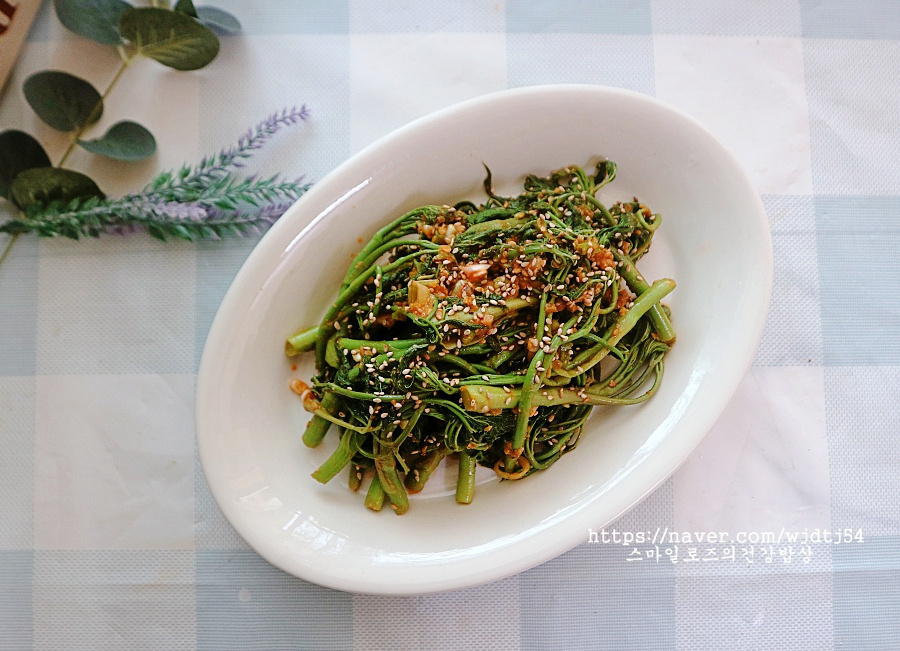Aromatic Spring Delight: Stir-Fried Mountain Yam Greens (Nunggaesongma)
Boost Your Health with Spring Greens: Enjoy Nunggaesongma Salad (Samnamul)!

As spring arrives, vibrant spring greens naturally find their way onto our tables. During this season of abundant fresh produce, I’d like to introduce one of my favorite spring dishes: ‘Nunggaesongma Namul’ (Stir-fried Mountain Yam Greens). Also known as ‘Samnamul,’ this delicacy is said to have three distinct flavors, creating a harmonious and profound taste. Nunggaesongma, a perennial herb found in mountainous regions across Korea, is rich in saponins and beta-carotene, making it excellent for anti-aging, skin health, and cancer prevention. It offers a unique taste profile reminiscent of ginseng, deodeok (a type of root vegetable), and meat. Furthermore, it’s known to aid in preventing cerebral infarction, brain diseases, and myocardial infarction, as well as possessing detoxifying, hemostatic, antipyretic, and aphrodisiac properties. Experience the slightly bitter yet delightfully chewy texture of Nunggaesongma by making a delicious salad with ssamjang (Korean savory paste) for a healthy spring meal!
Main Ingredients- 250g blanched and prepared Nunggaesongma
- 2 Tbsp finely chopped green onion
Seasoning- 1.5 Tbsp Ssamjang (Korean savory paste)
- 1 Tbsp Tuna extract (or fish sauce)
- 0.5 Tbsp minced garlic
- 1 Tbsp plum extract (or sweet syrup)
- 1 Tbsp ground sesame seeds
- 1.5 Tbsp toasted sesame seeds
- 1 Tbsp sesame oil
Ssamjang Ratio (Optional)- 1 Tbsp Doenjang (fermented soybean paste)
- 0.5 Tbsp Gochujang (red chili paste)
For Blanching- 0.7 Tbsp coarse sea salt
- 1.5 Tbsp Ssamjang (Korean savory paste)
- 1 Tbsp Tuna extract (or fish sauce)
- 0.5 Tbsp minced garlic
- 1 Tbsp plum extract (or sweet syrup)
- 1 Tbsp ground sesame seeds
- 1.5 Tbsp toasted sesame seeds
- 1 Tbsp sesame oil
Ssamjang Ratio (Optional)- 1 Tbsp Doenjang (fermented soybean paste)
- 0.5 Tbsp Gochujang (red chili paste)
For Blanching- 0.7 Tbsp coarse sea salt
- 0.7 Tbsp coarse sea salt
Cooking Instructions
Step 1
Preparing Nunggaesongma is quite simple. First, separate the tender leaf parts from the tougher stems. For the stems, thinly peel off the outer skin using a peeler to ensure a more tender texture.

Step 2
Here’s how to prepare the Nunggaesongma for optimal freshness. When you first receive it, soak it in water with a bit of baking soda for about 10 minutes, then briefly soak it in water with a little vinegar. Rinse thoroughly under running water. This helps remove any residual pesticides and ensures a cleaner taste. After rinsing, drain well.

Step 3
Bring a pot of water to a boil and add 0.7 Tbsp of coarse sea salt. Place the Nunggaesongma stems-down into the boiling water and blanch for about 30 seconds. Then, flip them over and blanch for another 30 seconds to 1 minute. Be careful not to overcook, as it can make the texture mushy.

Step 4
Immediately after blanching, rinse the Nunggaesongma under cold running water to stop the cooking process and preserve its vibrant green color and crisp texture. Gently squeeze out excess water by hand.

Step 5
In a mixing bowl, add a generous 1.5 Tbsp of Ssamjang. Mix in 1 Tbsp of tuna extract and 1 Tbsp of plum extract. If you don’t have Ssamjang, you can mix 1 Tbsp of Doenjang with 0.5 Tbsp of Gochujang.

Step 6
Add 1 Tbsp of ground sesame seeds, 1 Tbsp of sesame oil, and 0.5 Tbsp of minced garlic to the bowl to create the seasoning. Using too much garlic can overpower the natural flavor of the Nunggaesongma, so use it sparingly.

Step 7
Add the drained Nunggaesongma to the prepared seasoning. Also, toss in the 2 Tbsp of finely chopped green onion. The refreshing taste of green onion complements the greens beautifully.

Step 8
Now, it’s time to gently mix everything together with your hands. Toss lightly to avoid crushing the greens. Your Nunggaesongma salad with Ssamjang is ready, boasting a crisp texture and rich savory flavor! For a simpler taste, you can also season it with Korean soup soy sauce.

Step 9
Transfer the finished Nunggaesongma salad to a serving plate. Sprinkle generously with 1.5 Tbsp of toasted sesame seeds for a final touch. While this stir-fried version is delicious, Nunggaesongma can also be pickled or made into pancakes, making it a versatile ingredient.

Step 10
The chewy texture and complex flavor of Nunggaesongma, which is slightly bitter and reminiscent of ginseng and deodeok, have earned it the nickname ‘ginseng from the mountains.’ Enjoying it lightly blanched with a spicy-sweet red chili dipping sauce (cho-gochujang) is also delightful, as is this Ssamjang-seasoned version for a wonderful spring treat.

Step 11
Nunggaesongma offers a chewy texture and a complex flavor profile that evokes ginseng, deodeok, and even meat! Today, we’ve used Ssamjang for a robust taste, but feel free to mix Doenjang and Gochujang, or opt for a clean flavor with Korean soup soy sauce, depending on your preference. Enjoy experimenting with this versatile ingredient!




